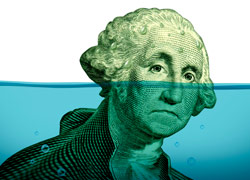Some traders prefer trading forex pairs in small volumes instead of the so-called “majors.” Find out which currency pairs are at risk of being “thinly traded” in this article.
Low liquidity
Forex liquidity refers to how much money flows through the market at any time. The liquidity of a trading instrument can be easily sold or bought at an established price when it is high.

The liquidity of an instrument increases with its trading volume. Liquidity varies among currency pairs, even though the forex market has the highest volume among all markets. There is a lot of liquidity in major currency pairs, unlike minor currency pairs or exotic currency pairs.
Slippage
You can see how quickly the price gaps occur on the chart if you examine it again. The price can change abruptly, so a trader can open an order at one price and have it executed at another.
Traders sometimes benefit from changes. Several reasons explain this phenomenon, including low liquidity, because finding buyers or sellers take longer because not enough players are in the market. It refers to slippage when an order’s price changes from when it goes through until it executes.
Profit taking
A low-liquidity asset has a limited number of market participants. A low-traded currency might be difficult to purchase or sell quickly. Consider buying an illiquid currency pair. As soon as you realize the price is good for short, you attempt to sell it, but no one is willing to buy it. Losing an opportunity is the result.
High spreads
In particular, liquidity plays an important role for retail traders in determining spreads (the ask / big price difference). Spreads for currency pairs of developing countries are larger due to low demand and, therefore, low trading volume.
To calculate the profit loss ratio taking these costs into account, remember that higher transaction costs accompany trading low-volume forex.
Why trade low-volume currency pairs?
Often news trading opportunities draw a trader’s attention too thinly traded currencies. The country is expecting the release of important economic data (e.g., interest rate). Some traders make impressive profits by speculating on these kinds of events. Further, it is simply not worthwhile to trade low-volume currency pairs.
How to trade low-volume currency pairs?
Trading forex pairs may seem confusing at first. Choosing a pair containing one major currency is reasonable if you want to trade exotics. The following pairs might be worth considering if you decide to trade low-volume pairs:
- JPY/NOK (Japanese yen/Norwegian krone);
- USD/THB (US dollar/Thailand baht);
- EUR/TRY (Euro/Turkish lira);
- AUD/MXN (Australian dollar/Mexican peso);
- USD/VND (US dollar/Vietnamese dong);
- GBP/ZAR (Sterling/South African rand).
Investing large sums of money into such a risky asset is also not a good idea. When starting, it is best to observe the behavior of a single pair of currency pairs over time. You might even want to test a few strategies on a demo account to see what works. Traders typically find success in news trading – this is where they occasionally succeed.

Bottom line
Considering all the risks, we conclude it’s probably bad to trade low-volume currency pairs. There are better ways to learn than trading exotics if you are new to the game.
Majors are a better bet as they are less likely to lead to such big financial losses as thinly traded currencies do when bad trades occur (which sometimes happen even in professional trading).
You might still want to consider trading low-volume currency pairs if you do so. It is not a good idea to trade multiple instruments simultaneously. Take the time to study one currency pair. Try different strategies until you find one that works. Investing in major currency pairs may not pay off if your efforts don’t bear fruit. Taking the easy route is sometimes worth it.
